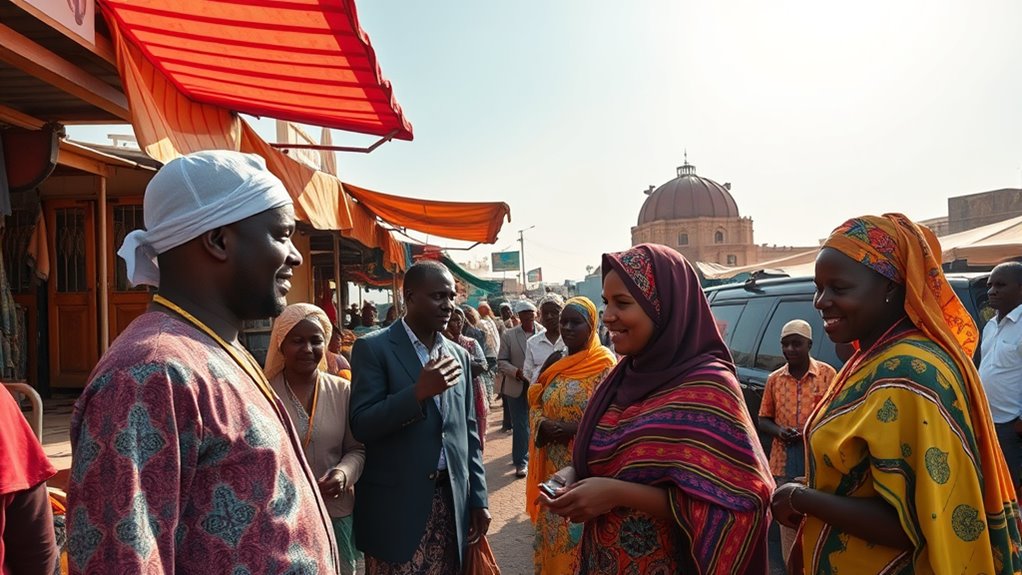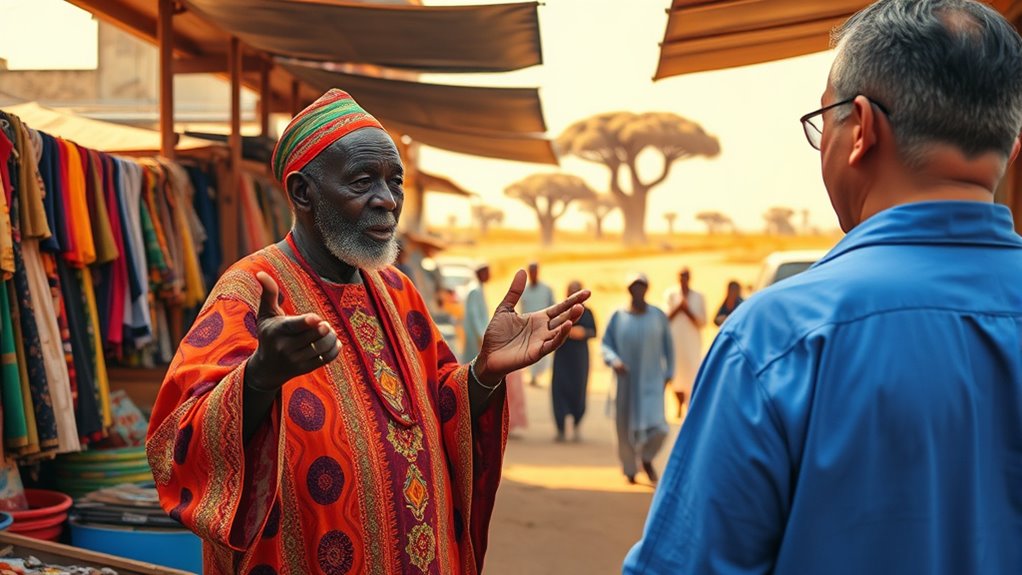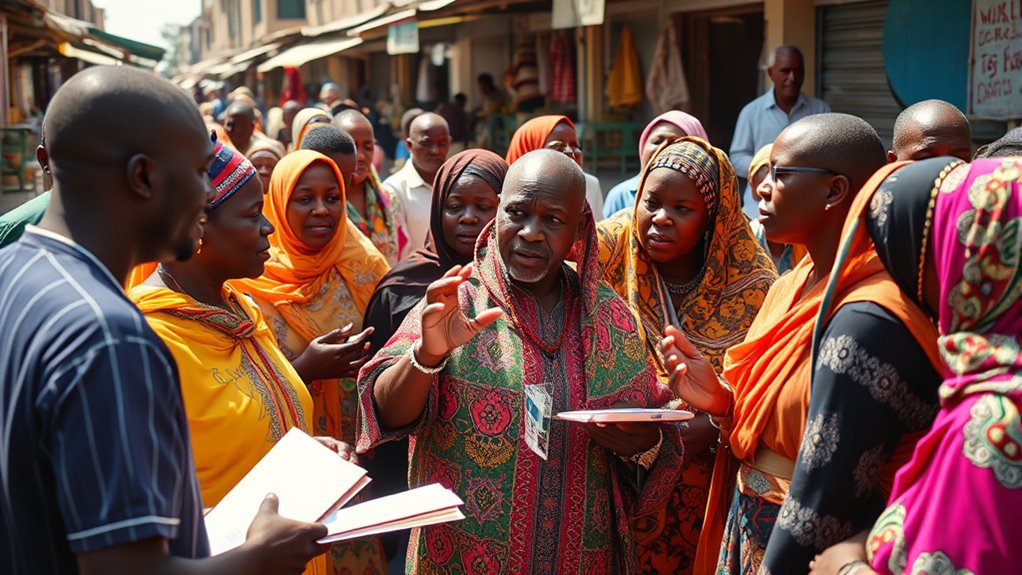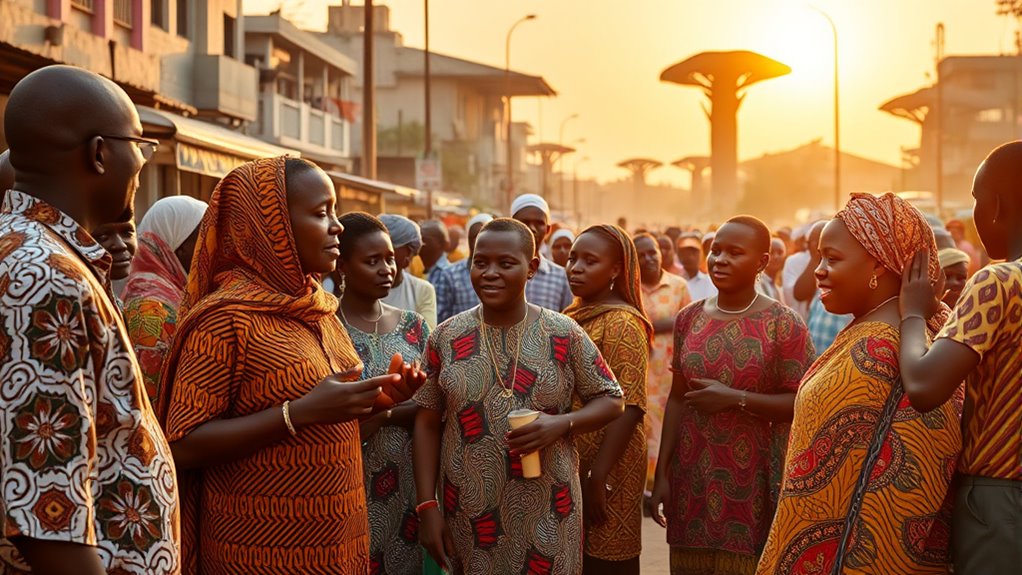Wolof to English translation is essential in Senegal’s multilingual context, where it bridges communication gaps among diverse languages and supports daily interactions, business, and diplomacy. This process requires expertise in handling tonal nuances, idioms, and cultural elements for accurate, natural renditions. In Africa’s broader translation landscape, it fosters regional unity and global exchanges. Professionals use specialized tools and techniques to guarantee fidelity. A deeper exploration of these practices uncovers valuable insights into vocabulary and methods.
Quick Summaries
- Professional translation services in Senegal specialize in accurate Wolof to English conversions for various contexts.
- Expert translators in Africa emphasize tonal nuances and cultural adaptation to ensure faithful Wolof to English translations.
- Bilingual dictionaries and online tools aid in efficient Wolof to English translation processes across Senegal.
- Certified translators bridge linguistic gaps, supporting business, education, and diplomacy in Wolof-speaking regions.
- Resources like language learning platforms help users master Wolof for effective English translations in African settings.
The Wolof Language Overview

The Wolof language, a member of the Niger-Congo family, is primarily spoken by about 5 million people as a first language, with millions more using it as a second tongue. It features a tonal system, where pitch distinguishes word meanings, and its grammar relies on subject-verb-object structure. Wolof’s vocabulary includes loanwords from Arabic, due to historical Islamic influences, and French, stemming from colonial ties. The language boasts rich oral traditions, including griot storytelling and proverbs that preserve cultural heritage. In Senegal, it dominates urban communication and media, fostering national unity. Dialects vary slightly across regions, such as the urban Dakar variant versus rural forms, yet remain mutually intelligible. Wolof’s script often uses a modified Latin alphabet, though Ajami (Arabic script) persists in religious contexts, reflecting its adaptive evolution. This overview highlights its enduring role in West African society.
English Translation Essentials

Translating Wolof into English demands attention to its tonal nuances and subject-verb-object grammar, ensuring accurate conveyance of meaning across cultural contexts. Effective translation requires understanding idiomatic expressions, where direct word-for-word conversion often falls short. Translators must navigate these complexities to preserve the original intent and emotional depth.
To enhance translation quality, consider the following essentials:
- Tonal Accuracy: Capture Wolof’s pitch variations, which can alter meanings, by using English equivalents that convey similar emphasis.
- Cultural Adaptation: Adjust proverbs and customs to resonate with English audiences without losing cultural essence.
- Grammatical Precision: Realign sentence structures to fit English norms while maintaining the source’s logical flow.
This approach fosters reliable, engaging translations in professional settings.
Senegal’s Linguistic Landscape

Senegal features a multilingual environment where Wolof predominates among over 30 languages, including French as the official tongue and regional ones like Pulaar and Serer. Wolof, spoken by about 40% of the population as a first language and understood by a majority, functions as a lingua franca in daily life, markets, and informal settings, fostering social cohesion. French, a legacy of colonial rule, dominates formal domains such as government, education, and media, ensuring administrative efficiency. Pulaar and Serer, among other indigenous tongues, play essential roles in ethnic identity, cultural practices, and rural communication. This diversity reflects historical migrations and trade networks, enriching Senegal’s social fabric. However, it poses challenges in national unity and policy implementation, prompting efforts to promote multilingualism while prioritizing French in official contexts. Balancing these languages supports cultural preservation and economic development in a dynamic nation.
Common Wolof Vocabulary
The common Wolof vocabulary includes basic greetings, everyday phrases, and number words, which are essential for everyday interactions. This vocabulary serves as a foundational tool for learners engaging in Wolof to English translation. Exploring these elements provides insight into the language’s practical usage.
Basic Greetings
Basic greetings in Wolof serve as essential tools for everyday communication, with phrases like “Salaam aleekum” translating to “Peace be upon you” in English. These expressions foster social bonds and show respect in Senegalese culture, often varying by context such as formal meetings or casual encounters.
In Wolof, mastering basic greetings enhances cultural understanding and facilitates interactions.
- Nanga def? – Meaning “How are you?” this inquiry promotes warmth and is commonly used among friends or acquaintances.
- Maangi fi? – Translating to “What’s your name?” it serves as a polite introduction, helping build rapport in new conversations.
- Jerejef – Equivalent to “Thank you,” it expresses gratitude after greetings, reinforcing positive exchanges and mutual respect.
Everyday Phrases
Everyday phrases in Wolof form the backbone of routine communication, encompassing practical vocabulary for activities like shopping, eating, and managing daily life, which helps speakers engage effectively in diverse social settings. For instance, phrases for shopping include “Dama wax” (I want) when selecting items, or “Naka la?” (How much is it?) to inquire about prices, facilitating smooth transactions at markets. In eating scenarios, expressions like “Jëréjef” (I’m full) or “Maa ngi japp” (Give me food) aid in mealtimes and social gatherings. Daily management phrases, such as “Dama togg” (I’m going) for departures or “Naka di?” (What’s happening?) for updates, enhance interactions in homes and communities. These versatile expressions promote cultural connectivity and efficient exchanges among Wolof speakers in Senegal.
Number Words
Wolof number words enable precise counting and quantification in everyday interactions, building on foundational vocabulary like phrases for shopping and daily exchanges. In Wolof, these terms form the backbone of numerical expression in Senegal, allowing speakers to handle everything from market bargaining to timekeeping. Derived from a rich linguistic tradition, they integrate seamlessly into conversations, enhancing clarity in commerce and social settings.
- Basic numbers: Wolof includes “ben” for one, “ñatt” for two, and “ñett” for three, used in simple counting like items in a store.
- Intermediate numbers: Terms like “fukk” for ten and “fukk ak ben” for eleven extend to everyday math, such as pricing goods.
- Advanced usage: Higher numbers, such as “taŋ” for hundred, appear in financial discussions, ensuring accurate quantification in negotiations.
Translation Techniques and Methods
Various techniques and methods form the foundation of Wolof to English translation, ensuring accuracy and cultural sensitivity. Literal translation involves direct word-for-word conversion, which maintains the original structure but may require adjustments for English grammar. Adaptive methods, such as dynamic equivalence, focus on conveying the intended meaning rather than exact wording, making the text more natural for English speakers. Translators often employ bilingual dictionaries and glossaries to handle specific Wolof vocabulary, like verbs and nouns with unique conjugations. Machine-assisted tools, including translation software, enhance efficiency by suggesting equivalents, though human oversight is essential for precision. Effective strategies also include back-translation, where the English version is retranslated into Wolof to verify fidelity. Overall, these approaches prioritize linguistic accuracy while handling structural differences between the languages.
Cultural Context in Translation
Cultural context profoundly influences Wolof to English translation by bridging the nuances of Senegalese traditions and idioms with English-speaking audiences. Translators must adeptly handle cultural elements like social hierarchies, oral storytelling, and symbolic language to avoid misinterpretations that could alter meanings. This guarantees translations resonate authentically, fostering cross-cultural understanding.
To add depth, consider these key aspects:
- Social norms: Wolof greetings often embed respect and community ties, requiring English equivalents that convey similar relational depth without losing intent.
- Proverbs and idioms: Senegalese proverbs, rooted in agrarian life, demand contextual adaptation to English to preserve their wisdom and humor.
- Rituals and folklore: References to ceremonies or myths in Wolof texts need careful translation to maintain cultural significance for non-Senegalese readers.
Professional Services for Wolof-English
Professional services are essential for effective Wolof-English translation, addressing the need for expert translators skilled in linguistic nuances. These specialists guarantee high-quality results by drawing on their proficiency in both languages. Accurate Wolof services, in turn, minimize errors and enhance cross-cultural communication.
Expert Translators Needed
In the domain of Wolof-English translation, expert translators play a pivotal role in delivering precise and reliable services for professional needs. These specialists bridge linguistic gaps in Senegal’s diverse contexts, such as business, education, and diplomacy, ensuring effective communication without cultural missteps. Their proficiency is essential for maintaining the integrity of translated content, particularly in high-stakes scenarios.
To highlight the importance of expert translators, consider the following:
- Linguistic Mastery: They possess deep knowledge of Wolof grammar, idioms, and nuances, preventing errors that could alter meaning.
- Cultural Expertise: Understanding Senegal’s traditions and social dynamics allows for contextually appropriate translations.
- Professional Reliability: Certified translators adhere to ethical standards, timelines, and confidentiality, fostering trust in global interactions.
This expertise drives successful cross-cultural exchanges in professional settings.
Accurate Wolof Services
Accurate Wolof-English services guarantee precise and reliable translations for diverse professional needs, building on the expertise of skilled translators to facilitate effective cross-cultural communication in fields like business and diplomacy. These services employ native speakers and certified linguists who understand Wolof’s linguistic complexities, ensuring fidelity to cultural contexts and idioms. In Senegal, where Wolof is predominant, such accuracy prevents misunderstandings in legal, medical, and educational sectors. Professionals rely on advanced tools like CAT software to maintain consistency and speed, enhancing global interactions. By prioritizing confidentiality and quality assurance, these services foster trust and efficiency, ultimately supporting economic and social bridges between Senegal and English-speaking regions. This precision not only aids diplomacy but also drives successful international collaborations.
Tools and Resources for Translators
Translators handling Wolof to English conversions often utilize specialized tools and resources to enhance accuracy and efficiency in their work. These aids help navigate the language’s unique tonal and structural elements, ensuring precise cultural adaptations. By leveraging digital solutions, professionals can streamline processes and minimize errors in diverse contexts like business or education.
To add depth, consider these essential resources:
- Online Translation Software: Platforms like Google Translate or specialized apps provide instant conversions, though they require human oversight for nuanced Wolof phrases.
- Bilingual Dictionaries and Glossaries: Thorough resources from organizations like SIL International offer detailed vocabulary, aiding in context-specific translations.
- Language Learning Platforms: Tools such as Duolingo or Rosetta Stone include Wolof modules, helping translators build proficiency and cultural knowledge for better accuracy.
Historical Evolution of Wolof
The Wolof language has evolved over centuries, shaped by migrations, trade routes, and colonial influences in West Africa. Originating from the Senegal River valley, Wolof likely descended from Proto-Atlantic languages, emerging as a dominant tongue among the Wolof people by the 14th century. As trade networks expanded along the Gambia and Senegal rivers, Wolof incorporated Arabic loanwords through Islamic scholarship, enriching its vocabulary for commerce and religion. European contact, particularly during the 15th-century Portuguese era and later French colonization in the 19th century, introduced further linguistic shifts. French rule accelerated bilingualism, leading to code-switching and lexical borrowing, while post-colonial independence in 1960 fostered standardization efforts. Today, Wolof’s evolution reflects a dynamic interplay of cultural resilience and external pressures, maintaining its role as an essential Senegalese language. This historical trajectory underscores its adaptability amid social changes.
Practical Phrases for Daily Use
Wolof provides essential phrases for everyday communication, enabling learners to navigate daily interactions in Senegal and beyond. These phrases facilitate basic exchanges, from greetings to transactions, fostering cultural immersion. By mastering them, individuals can engage more effectively in social and commercial settings.
Learning practical Wolof phrases enhances accessibility and builds rapport. Here are key examples:
- Greetings: Phrases like “Nanga def?” (How are you?) and “Jërëjëf” (Thank you) promote polite introductions and responses.
- Shopping and bargaining: Expressions such as “Bëgg na?” (How much is it?) and “Duma” (Cheap) aid in markets and negotiations.
- Daily requests: Terms like “Maangi” (I want) and “Dañu” (Give me) assist with common needs, such as ordering food or asking directions.
This approach supports practical language acquisition for real-world use.
Challenges in Accurate Translation
While cultural nuances and linguistic differences often hinder precision, accurate translation from Wolof to English requires handling complexities such as idiomatic expressions and structural variances that do not align directly between the languages. For instance, Wolof idioms, which often embed cultural proverbs or metaphors rooted in Senegalese traditions, rarely have exact English counterparts, leading to potential misinterpretations. Structural differences, like Wolof’s flexible word order and agglutinative features, complicate direct conversion to English’s more rigid syntax. Additionally, tonal elements in Wolof can alter meanings subtly, which English lacks, making translators rely on context to avoid errors. Regional dialects of Wolof further challenge uniformity, as variations in vocabulary and pronunciation demand specialized knowledge. Overall, these factors underscore the need for culturally informed expertise to achieve fidelity in translation.
Business and Communication Applications
Businesses leverage Wolof-English translation to facilitate international trade and cross-cultural communication, particularly in Senegal and surrounding regions. This tool streamlines negotiations, marketing strategies, and daily operations by bridging linguistic gaps, enabling smoother interactions with English-speaking partners. It enhances efficiency in global commerce, from contract drafting to client engagements, while promoting trust and accuracy in exchanges.
- Enhanced Trade Deals: Accurate translations guarantee clear contract terms, reducing misunderstandings and boosting successful partnerships in international markets.
- Improved Marketing Efforts: Businesses adapt campaigns to Wolof-speaking audiences, increasing engagement and sales through culturally resonant English-Wolof content.
- Streamlined Communication: Real-time translation tools facilitate emails, calls, and virtual meetings, fostering collaboration and operational productivity in diverse teams.
Regional Dialects in Senegal
Senegal’s diverse regional dialects, including Pulaar, Serer, and Jola, shape its linguistic landscape and interact with Wolof in everyday use. Pulaar, spoken by the Fula people, features tonal elements and nomadic influences, often blending with Wolof in trade and rural settings. Serer dialects, prevalent in central regions, emphasize agricultural traditions and share vocabulary with Wolof, facilitating community interactions. Jola variations in the south incorporate unique rhythms and expressions, enriching cultural exchanges. These dialects contribute to Senegal’s multilingualism, where code-switching with Wolof occurs in markets, festivals, and family life, promoting social cohesion. While Wolof serves as a lingua franca, regional dialects preserve ethnic identities and folklore, influencing translation practices by adding layers of nuance and context. This interplay underscores Senegal’s vibrant linguistic diversity, essential for effective communication across communities.
Future Trends in African Translation
As technological advancements accelerate, future trends in African translation are reshaping cross-cultural communication by integrating artificial intelligence and machine learning. This integration enhances accuracy and accessibility for languages like Wolof, fostering broader inclusivity in global interactions. Emerging technologies are poised to transform the field through innovative applications.
- AI-Driven Real-Time Translation: Tools like neural networks enable instant, context-aware conversions, reducing errors in dynamic settings such as business or education.
- Machine Learning for Dialect Adaptation: Algorithms learn from diverse African dialects, improving customization and preserving cultural nuances in translations.
- Collaborative Human-AI Models: Hybrid systems combine expert linguists with automation, ensuring ethical and contextually rich outputs for Senegal’s multilingual landscape.
Frequently Asked Questions
How Much Does Wolof-English Translation Cost?
The query regarding the cost of Wolof-English translation services varies widely. Factors such as word count, complexity, and provider expertise influence pricing. Typically, rates range from $0.05 to $0.20 per word, though exact fees depend on specific agreements and market conditions.
What Is the Typical Turnaround Time?
The typical turnaround time for services varies widely, often ranging from a few hours to several days, depending on factors like project complexity, volume, and provider efficiency. Industry standards suggest faster times for simpler tasks, impacting client planning.
Do You Offer Certified Translations?
The current question inquires whether certified translations are offered. The service provides them, ensuring accuracy, official verification, and compliance with international standards for documents in legal, educational, and business contexts.
How Can I Get a Quote Quickly?
In response to the query on how to obtain a quote quickly, the service provider recommends submitting details via their website’s form for fast processing or contacting support directly, ensuring a prompt reply within minutes.
Are There Discounts for Multiple Projects?
When inquiring about discounts for multiple projects, clients should contact the service provider directly. Discounts may be available for bulk orders, depending on factors like project volume, complexity, and overall client commitment, to foster long-term partnerships.



